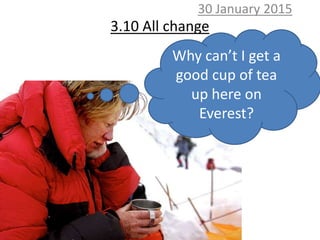
3.10 all change
- 1. 3.10 All change 30 January 2015 Why can’t I get a good cup of tea up here on Everest?
- 2. Aims • Describe what happens when solids melt and liquids evaporate • Explain what happens when gases condense and liquids freeze
- 3. Changes of state • Almost all substances can exist as solids, liquids and gases at different temperatures • We live in England where water is usually a liquid but if we lived in Antarctica it would usually be a solid. It can also be a gas.
- 4. Melting • Strong forces join the particles in a solid together • The particles can only vibrate and they cannot move around • When a solid is heated up, its particles vibrate so much that some of the forces are overcome • The particles can now move around each other • Melting has happened to turn the solid into a liquid
- 7. Melting point • The temperature at which something changes from a solid to a liquid is called its melting point • Different substances have different melting points • Ice melts at 0oC but iron melts at 1583oC • The stronger forces holding the particles together, the higher the melting point
- 8. Condensing • When a gas is cooled, its particles move around more slowly • If the gas gets cold enough, its particles move slowly enough for forces to attract them together again • Condensing has happened to turn the gas into a liquid
- 11. Evaporating • When a liquid is heated up, its particles move around more quickly • Some particles move around so much that almost all of the forces between them are overcome • The separate particles escape from the surface of the liquid • Evaporating has happened to turn some of the liquid into gas
- 12. • The more the liquid is heated, the faster evaporating happens • Boiling happens when evaporating takes place throughout the liquid • The temperature at which something boils is called its boiling point • The boiling point of a liquid depends on the pressure of the air around it • The lower the pressure, the lower the boiling point
- 14. 3.10 All change! Questions 1. The melting point of ice is 0°C. In what state is it: a. at 25°C? b. at –10°C? 2. Explain what these words mean: melting, evaporating, condensing, freezing. 3. Air contains water vapour. Water vapour is separate particles of water. Why do droplets of water form on cold windows? (Level 3) (Level 3) (Level 4) 1 of 3
- 15. 3.10 All change! Questions 4. If you put wet washing outside on a washing line, it soon dries. Martin thought that this was because the heat from the Sun boiled the water in the clothes. Was he right or wrong? Explain your answer. 5. The boiling point of a substance is always higher than its melting point. Explain this observation using the idea of particles and the forces between them. 6. Iodine is unusual. It turns directly from a solid into a gas when warmed up. Suggest why this happens. Use the idea of particles and the forces between them in your answer. (Level 5) (Level 6) (Level 7) 2 of 3
- 16. 3.10 All change! Questions 7. Instant coffee is made by ‘freeze drying’ it at the factory. Instead of heating the coffee to boil off the water, it is put under very low air pressure and the water rapidly escapes. a. Explain why the water escapes rapidly from the coffee even though it is not at 100°C. b. Suggest why the coffee may actually freeze during this process. (Level 7) 3 of 3
- 17. 3.10 All change! For your notes Forces between particles are overcome when something melts or boils. The stronger the forces, the higher the melting point and the boiling point. Liquids boil at lower temperatures when under lower pressure. 1 of 1